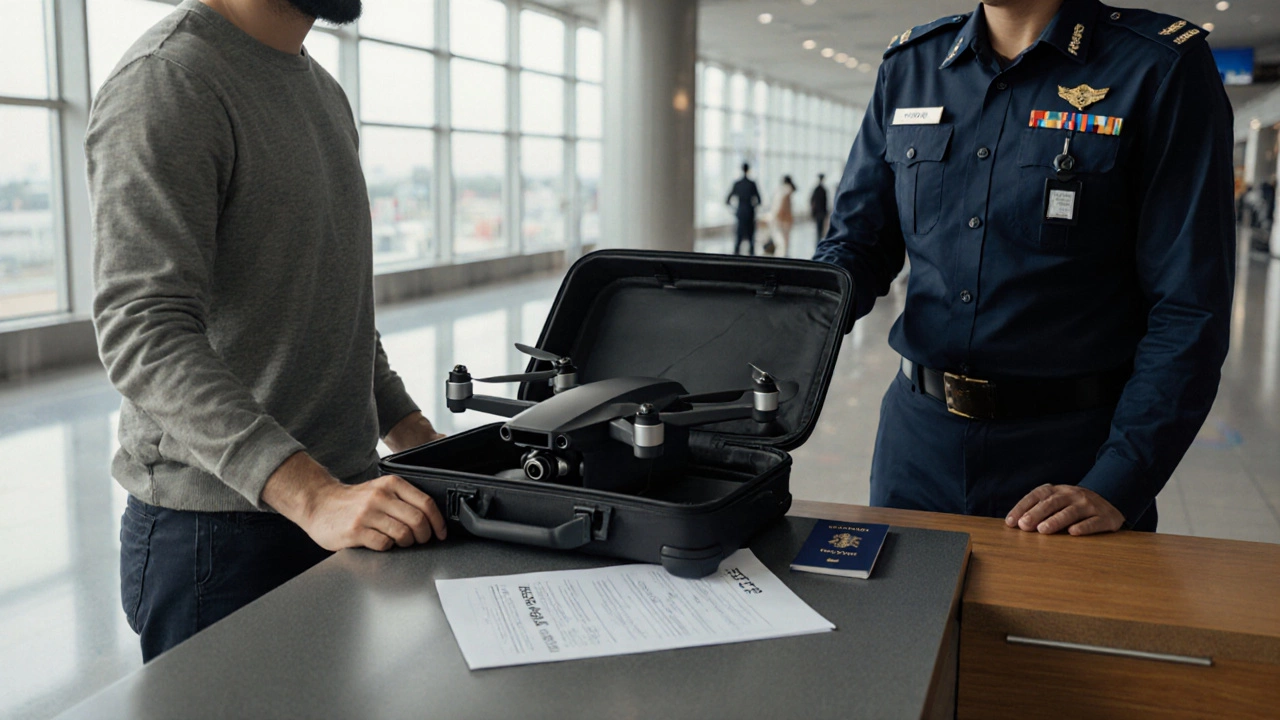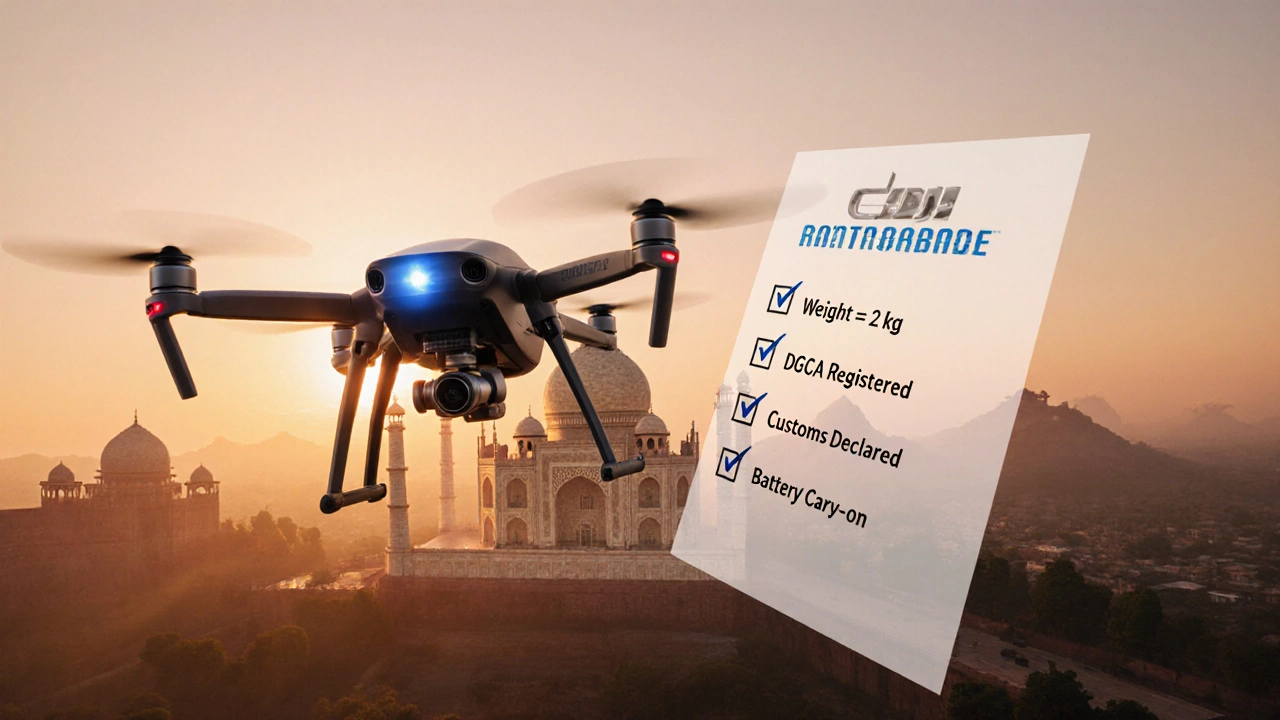Can I Carry a DJI Drone to India? Rules, Duties & Tips
 Oct, 21 2025
Oct, 21 2025
India Drone Customs Duty Calculator
Calculate Your Drone Import Duty
Duty Calculation Result
Based on Indian customs regulations
Weight Classification
Required Documents
Quick Takeaways
- India classifies drones by weight; anything under 250 g is exempt from most permits.
- All DJI drones above 250 g need DGCA registration and a No Permission No Takeoff (NPNT) certificate before you can fly.
- Customs duty ranges from 0 % to 20 % depending on the drone’s value and whether you have a valid import licence.
- Carry batteries in carry‑on luggage, not checked bags, and keep a copy of the safety data sheet.
- Plan ahead: apply for the DGCA online portal at least 7 days before arrival to avoid delays.
Traveling with a DJI drone India can feel like navigating a maze of paperwork, taxes and technical rules. The good news is that most of the red tape is predictable once you know which authorities are involved and what they expect. This guide walks you through the entire process - from packing the gear to clearing Indian customs and getting the green light to fly the moment you land.
DJI is a Chinese technology company best known for its consumer and professional drone lineup. Models such as the Mavic 3 and the Air 2S fall under the category of “small‑to‑medium” UAVs that most travellers carry for aerial photography.
India enforces a set of civil‑aviation rules overseen by the Directorate General of Civil Aviation (DGCA). These rules determine who can import a drone, how much duty you pay, and whether you can launch the aircraft in Indian airspace.
Understanding Indian Drone Classification
The DGCA groups unmanned aircraft systems (UAS) by their maximum take‑off weight (MTOW). The three main brackets matter for both customs and flight permission:
- Micro drones (≤250 g) - No registration or NPNT required. Ideal for casual travel.
- Small drones (251 g-2 kg) - Must be registered on the DGCA portal and obtain an NPNT certificate.
- Medium drones (2 kg-25 kg) - Same as small drones, plus you need a special permission from the Ministry of Civil Aviation for commercial use.
Most DJI consumer models sit in the second bracket. The Mavic 3, for example, weighs about 895 g, so you’ll need to complete the registration process before your first flight.
Step‑by‑Step: Clearing Indian Customs
When your luggage hits the customs desk, officers will check two things: the declared value of the drone and whether you have the paperwork to prove it’s a personal‐use item.
| Drone Weight | Typical Duty % | Required Docs |
|---|---|---|
| ≤250 g | 0 % | Invoice, personal ID |
| 251 g-2 kg | 10‑20 % | Invoice, DGCA registration proof, NPNP certificate |
| >2 kg | 15‑20 % | Invoice, DGCA registration, Ministry of Civil Aviation permit |
Key tips to keep the duty low:
- Carry the original purchase invoice (or a printed e‑receipt) showing the drone’s value.
- If you’re a visitor, declare the drone as a “personal effect” and be ready to prove you’ll take it back home.
- For Indian residents, apply for an import licence through the Ministry of Civil Aviation’s online portal. The licence can shave up to 5 % off the standard duty.
Getting DGCA Registration & NPNT Certificate
The DGCA’s online portal (dgca.gov.in) is where you’ll register any drone above 250 g. Here’s the flow:
- Create an account using your passport number and email.
- Fill in the drone details - model, serial number, weight, and intended use.
- Upload a copy of your passport, a recent photograph, and the purchase invoice.
- Pay the nominal registration fee (≈ ₹ 2,000 for small drones).
- Once approved (usually within 48 hours), download the No Permission No Takeoff (NPNT) certificate.
The NPNT certificate is a digital key that must be active on the drone’s firmware. DJI’s latest firmware versions automatically check the certificate each time you power up. If the certificate is missing, the drone will refuse to take off.
Battery & Carry‑On Rules
Lithium‑polymer (LiPo) batteries are classified as hazardous goods. Indian aviation regulations require you to keep them in the cabin, not in checked luggage. Follow these steps:
- Carry each battery in its original protective case or a dedicated battery bag.
- Limit the total capacity to 100 Wh per battery; DJI drones usually stay under this limit.
- Bring the safety data sheet (SDS) for the batteries - a quick PDF you can print from DJI’s support site.
If you forget these steps, customs may confiscate the batteries, and you’ll be unable to fly.
Special Considerations for Commercial Shoots
Planning a wedding shoot, real‑estate video or a film project in India? You’ll need extra clearances beyond the standard registration:
- A Civil Aviation Requirement (CAR) - DO 107 endorsement, which you can request through the DGCA.
- Permission from the Airports Authority of India (AAI) if you intend to fly near any airport.
- A local liaison or a certified “UAV Operator” who can vouch for the safety standards during the shoot.
Without these, you risk a hefty fine (up to ₹ 50,000) or even seizure of the equipment.

Common Pitfalls and How to Avoid Them
Even experienced travellers slip up. Here’s a short checklist to keep you on track:
| Item | What to Do |
|---|---|
| Registration | Complete DGCA registration at least 7 days before departure. |
| NPNT Certificate | Ensure firmware is updated; upload certificate. |
| Customs Declaration | Carry original invoice and a printed copy of registration. |
| Batteries | Pack in carry‑on, keep each under 100 Wh, bring SDS. |
| Commercial Permission | Apply for CAR‑DO 107 and AAI clearance if needed. |
Missing any of these items usually leads to a delay at the airport, a surprise duty bill, or a denied take‑off permission.
What Happens If You Fly Without Clearance?
The DGCA monitors drone activity via a built‑in transponder that reports to the national air traffic system. If you launch a DJI drone without an active NPNT certificate, the system will flag the aircraft as “unauthorised.” Consequences can include:
- Immediate grounding of the drone by the onboard safety lock.
- A fine ranging from ₹ 5,000 to ₹ 50,000 depending on the severity.
- Potential criminal charges for violation of the Unmanned Aircraft System (UAS) Rules 2021 if the flight caused safety risks.
For tourists, the easiest remedy is to surrender the drone at the nearest DGCA office, pay the fine, and obtain a retroactive registration - but this process can take weeks.
Wrapping Up: Your Roadmap to a Smooth Arrival
In short, bringing a DJI drone to India is absolutely doable, but you must respect three core pillars: weight‑based classification, customs duty transparency, and DGCA‑mandated registration with an active NPNT certificate. Follow the checklist, keep your paperwork digital and printed, and you’ll be soaring over the Taj Mahal or the Western Ghats in no time.
Do I need a DGCA registration for a DJI Mavic Mini (249 g)?
No. The Mavic Mini falls under the micro‑drone category (≤250 g) and is exempt from registration and NPNT requirements. You only need to follow the standard customs declaration.
How long does the DGCA registration process take?
Typically 24‑48 hours after you submit all documents and pay the fee. During peak travel seasons, allow up to 5 days.
Can I bring spare DJI batteries in checked luggage?
No. Indian aviation rules classify LiPo batteries as hazardous. They must travel in carry‑on bags, each under 100 Wh, and be protected from short circuits.
What is the NPNT certificate and why does my DJI drone need it?
NPNT stands for “No Permission No Takeoff.” It is a digital authorization stored in the drone’s firmware. Indian law requires any UAS above 250 g to have an active NPNT certificate before it can lift off. Without it, the drone’s motors will not start.
Is there a way to reduce customs duty on my DJI drone?
If you’re an Indian resident, applying for an import licence through the Ministry of Civil Aviation can lower the duty by up to 5 %. For tourists, declaring the drone as a personal effect and providing proof of re‑export can sometimes result in a duty waiver, but it’s at the officer’s discretion.